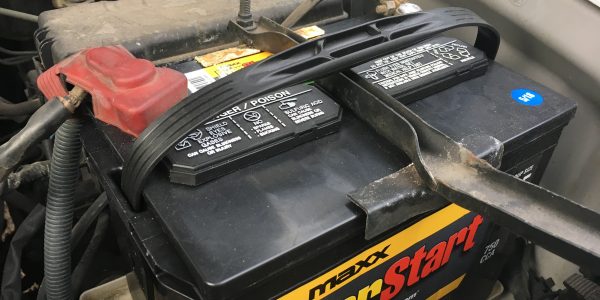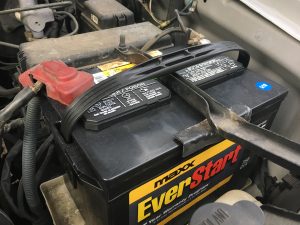In the last two weeks I have had to deal with two dying batteries. As a mechanic these are fairly easy for me to see them coming and be able to avoid an inconvenience. To many of you it might not be as simple to see this coming. Let’s go over some of the basics of the automotive electrical system. Then I’ll go over some of the warning signs and what they mean.
How Much Electricity Does Your Car Use?
Gizmos
Vehicles these days have more and more electronic gizmos and gadgets. Navigation systems, front and rear entertainment systems, higher powered stereos, Bluetooth, and some even have Wi-Fi hotspots in them.
Safety systems
Then there’s the layers of electrical safety systems. Antilock Braking Systems (ABS), Supplemental Restraint Systems (SRS), Vehicle Skid Control (VSC), and now even Collision Avoidance systems to name a few.
Features
That’s not mentioning that most cars now come standard with power windows, power locks, immobilizer systems, and automated climate control systems.
Systems that make your car go
Those are just the bells and whistles you think about and see on a daily basis. The systems you don’t think about are electrically controlled transmissions and clutches, engine management systems (fuel injection and spark control) and emission reduction systems.
In High Demand
As you can see, we demand a lot from the electrical system in our cars. What provides all that electricity? It’s a fairly simple system that supplies adequate clean power for all of the above systems. The electrical supply system is made up of a battery and an alternator. For now I’ll skip over the hybrids and full electric vehicles due to their added complexities.
The Battery
Let’s start with the basics so we’re all on the same page. The battery is basically a large energy storage unit for your vehicle. The primary reason it has to be so big is that the starter motor takes a lot of electricity in a short amount of time to start the vehicle.
The Alternator
Once the vehicle is started the second part of the electrical supply system kicks in. The alternator takes a small amount of rotational power from the engine and provides clean electrical power. The alternator provides enough power to run the engine and all the accessories in your car. It also provides enough energy to replenish what was taken out of the battery while starting the vehicle.
Warning Signs
- The engine seems to crank slowly when you turn the key to start the engine: Dying battery or low battery.
- The clock doesn’t keep the correct time consistently: Dying battery, low battery or shorted battery.
- The headlights seem dim at night: Dying battery or low battery.
- The radio doesn’t keep it’s station memory values: Dying battery, low battery or shorted battery.
- The vehicle will drive a short distance and then will stall and need a jump start. Once jump started it will drive another short distance and stall again: Corroded cable ends or bad alternator.
- The starter clicks like it’s stuttering: Dying battery, low battery or shorted battery.
- The dash lights go dead and nothing is heard under the hood when attempting to start: Dying battery, low battery or shorted battery.
- The vehicle exibits weird driveability issues like it doesn’t want to idle correctly, the automatic transmission shifts erratically, or electrical systems in the vehicle don’t behave normally: Bad alternator, dying battery or both.
Issues:
Dying battery, low battery or shorted battery:
This could be caused by the battery being bad internally. An internal short that causes it to not take a charge.
This could also be caused by the battery being low on fluid. Most general car batteries are flooded lead acid batteries. As the battery charges it warms up. When the acid warms up sometimes the water in it can evaporate. This leaves a high acid concentration. Sometimes you just need to add some distilled water to the battery to bring it back up to the right level.
Corroded cable ends:
This could be caused by the battery cable ends being corroded. If there is corrosion between the battery cable end and the post the alternator won’t be able to charge the battery adequately. If this is left too long the battery will slowly die. Depending on how long this goes on it could kill the battery completely.
This could also be corrosion between the battery cable end and the battery cable. I have seen corrosion work it’s way into the many strands of a battery cable. This caused a high resistance in the cable and the alternator couldn’t charge the battery enough.
Bad alternator:
When a battery is dead it’s not always the battery that is at fault. If the alternator doesn’t provide enough electricity to maintain the battery while also running the vehicle, the battery will suffer. If it only minimally charges the battery each day the battery will eventually be low enough to not start the vehicle. Car batteries are meant to see shallow discharge cycles.
On one occasion I had a customer bring me a car that was diagnosed as needing a new transmission. The car would drive normally for a while then randomly it would idle rough at a stoplight when in gear. If you took it out of gear it would idle normally. This points to a transmission problem. A problem with shifting as it was not shifting back down into first gear. I did a little research on this problem and found that this transmission was electronically controlled. With all of the electronic demands of the car I found that the alternator wasn’t producing enough clean power. I replaced the alternator and all of the driveability issues with the transmission disappeared. This proper diagnosis saved the car owner several thousand dollars and a couple weeks of time. This goes to show how adequate clean power can make a car run better.
Basic Tests:
Test the battery at rest to see if there is adequate power. You can use a good inexpensive auto-ranging voltmeter to test this. Set the voltmeter to read DC Volts and touch the positive (+) battery terminal with the red test lead. Touch the negative (-) battery terminal with the black test lead. A battery at rest should be sitting around 12.78V (volts). Usually if the battery is under 11V it won’t even start the vehicle.
Test the battery and the terminal ends to see if the battery has adequate power and if the terminal ends have any power loss in them.
- From positive (+) post to negative (-) post (you probably already did this in the previous step).
- From positive (+) post to negative (-) cable end.
- From positive (+) cable end to negative (-) post.
- From positive (+) cable end to negative (-) cable end.
If any of the numbers are different then you have found loss between the cable ends and the posts and should clean or replace them.
If the vehicle will start you can do a basic voltage test of the alternator with the same voltmeter. After the engine is running, touch the battery terminals the same as above. The minimum voltage should be 13.6V. Maximum should be about 15V. If it’s more or less than that it isn’t charging correctly. If you’ve ruled out the battery cable ends and battery cable corrosion then it is time to replace that alternator.
Things you should avoid
If the vehicle is driven on lots of short trips it’s possible that the battery won’t get recharged enough. Take a longer trip and if you have an older car, get the RPMs up around 2000-2500. The alternators in older cars aren’t as efficient as newer ones and need the extra RPMs to create the charge.
If the vehicle is only driven once a month the battery can discharge and become weak. If you have a car that is only driven occasionally there are a couple things you can do. Start the car and let it run for 10-15 minutes to recharge the battery. Or better yet, just take it for a drive. Another solution would be to get a trickle battery charger.
Tools you may need:
auto-ranging digital multimeter: a good inexpensive auto-ranging digital multimeter under $10
trickle battery charger: a good trickle battery charger that you can use on cars and trucks as well as motorcycles for under $20


